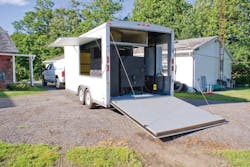When citizens are looking to unload some old ammunition, they can call their local sheriff. But who can the sheriff call?
“We had a horrible time getting rid of our ammunition, as did most services in Ontario,” says Jan Griese, supervisor of property and evidence with the Hamilton (Ontario) Police Service. “Our ERU (SWAT Team) used to take it to a quarry and burn it, but we had trouble getting rid of the waste afterwards.”
At the time, bomb techs with the Hamilton PD operated a crude burning rig—a 45-gallon steel bin—layered with wood chips, ammo, and then gingerly drizzled with a dose of diesel fuel. Sound familiar?
It wasn’t long before the region’s Minister of the Environment got involved and suggested the agency (and others) find a safer way to get rid of rounds. “They might contain it, or it might just pop off and they’d have to clean the area up the next day,” remembers Tom Braithwaite, then a civilian employee with the agency. “I told our guys at the time that they hadn’t fixed anything here; but you know the Ministry’s still going to shut you down … why don’t you just go buy a good burner. And they said to me ‘Well, nobody makes a good burner.’”
So Braithwaite figured he would. He’s now president and chief operating officer of Canadian Ammunition Disposal Services (C.A.D.S.) and TWB Designs (a sister company of CADS), having developed the Environmental Mobile Ammunition Combustion System—or eMACS—in 2001. In 2011 the burner was a Cygnus Law Enforcement Group’s Innovation Awards finalist. The buzz continues as agencies across Canada and the US discover the new ‘no muss, no fuss’ system of safely disposing of live ammunition.
The fire pit on wheels
“I’m very proud of it; I’ve got my heart and soul in this thing and I know every nut and bolt on it … because I’ve got everything in it.”
Braithwaite partnered with the Royal Canadian Mounted Police (RCMP) in Ottawa to develop a “better burner”. Hunkered down at a table with bomb techs and end users, he began by taking requests: It needed to be portable and propane-fired. It needed to do a batch-feed, and have a quick turnaround to boot (about an hour). It had to be remotely activated, and of course, have a small footprint. The eMACS burner was designed as an affordable and compact means of disposing up to 60 pounds of ammunition per hour, at one time. Its enclosed design enhances safety in a big way during the thermal process; it also ensures that any particulate released during the burning inside the chamber is eliminated before venting to the outside atmosphere. The eMACS promises not only quick disposal, but quick disposal in accordance with provincial laws. The eMACS currently exceeds California, EPA, NATO and EU standards. It is also endorsed by the Natural Resources Canada. Says Giese: “Just the environmental aspect of it is good. We feel comfortable that we’re not putting things into the air that shouldn’t be. It’s a safe and service has been top-notch.”
Braithwaite says they can process 100 pounds at a time, but it’s tougher on the trays. Out of about 1000 pounds processed per day in 8012 loads, the lead separates from the brass when the cycle is complete, ready for recycling. “You’ve got the yellow brass in the trays and the ingot of clean lead down below; you take that in for recycling and it works out to about $1/pound. Out of the 1000 pounds you processed that day, you almost make in return about $1000/day. So it’s very good for the environment, recycling, cost recovery, and your cost for your diesel fuel for the day is probably going to be about $90. In time I guess, it would pay for itself.”
Braithwaite made the very first MACS burner totally out of wood. The unit, he jokes, will hopefully turn up in his museum some day. After the RCMP approved of this prototype, they gave the go-ahead and he built a steel structure next. “We … did our very first test burn, and it worked phenomenally well,” he says. “So we’ve just modified the tray systems and different types of burners to get a little more efficiency out of it, and really since the very first one that’s all we’ve done to it. It’s worked well right from the start.”
Bullets and fireworks and flares—oh my!
When an agency stockpiles a lot of ammo that needs to be destroyed, they can schedule the eMACS truck to come do a pick up. The Peel Regional Police Service in Ontario has used Braithwaite’s burner since 2009. They’re often left wondering what to do with ammo acquired from seizures, training and that stuff that was—for one reason or another—turned in by the public. Peel is the third largest municipal police department in Canada, with close to 2,000 officers. When you consider anyone can turn in anything at any time—it adds up to quite a pile.
The eMACS is not ammunition-exclusive. In addition to marine flares it can dispose of pyrotechnics, firecrackers, pepper spray cans, etc. Peel Police Service Staff Sergeant Larry Walker did a lot of research before deciding eMACS was the way to go. Now they call up Braithwaite when they need to dispose of “everything up to 50 caliber” … including shotgun and .22 shells, even marine flares. “We have a fairly large boating population here and when the flares become expired, there’s no real method for boaters to get rid of them other than hopefully not tossing them overboard or putting them in the regular garbage,” says Walker. “We can’t afford it to go to landfill, even though landfill sites are pretty secure here, nobody can get into them, it’s not the right thing to do.”
In 2010 C.A.D.S. disposed of 1270 pounds of ammo for the Peel Police Service, and 250 marine flares. In 2011, ammo fell to 700 pounds but flares jumped to 1030 (likely to an increased promotion of the flare program within yacht and boating clubs). “[Flare disposal’s] been a problem for many, many years,” says Walker. “There’s no real set way of doing it. A lot of places in the US and in Canada basically tell boaters just go to your local police and turn them in, but they’re not really equipped to take them, so we set up the program here with proper bins and proper storage facilities, and then Tom comes in and he takes them away for us. He charges per flare and he charges per pound for the actual ammunition disposal, but it’s certainly cost-effective for us.”
Good work for a good reason
The eleven existing eMACS systems mostly serve law enforcement in Canada; one resides in Australia and one more was shipped out to Dubai PD. Braithwaite is now concentrating on the US and beyond, armed with an upgraded filtration system, and having EPA and NATO requirements under his belt. In the states, C.A.D.S. has partnered with representatives of the Wounded Warrior Project to help returned military vets find jobs doing disposal work with the eMACS. So far, it’s been a successful endeavor. “The marines that come back from Afghanistan … if they have an injury, they’re partially blind or they’re deaf … and they can’t go back to being a bomb tech, those are the people we hire,” says Braithwaite. “They love that they can still do what they love to do and we understand their situation.”
According to Braithwaite, the concept was a hard-sell at first. But now almost everyone in Southern Ontario is either using the service, or is at least interested in learning about it. In fact, some of the police services that were once skeptical have jumped onboard. The bullet-burning business on wheels is easy to use, versatile and thorough in what it does, but agencies using the service most appreciate the fact that it simply offers a clean alternative to the way things used to be. The “new kid in town” meets agencies’ efforts to be efficient, safe and environmentally conscious.
Where does ammo go when it dies? Let’s take a look at the possibilities …
About the Author

Sara Scullin
Sara Scullin was the Editor of Law Enforcement Technology magazine, a monthly business-to-business publication that covers technology trends and best practices for public safety managers. LET is part of SouthComm Law Enforcement Media, which also publishes Law Enforcement Product News and Officer.com. Sara had covered the law enforcement industry since March 2008.
